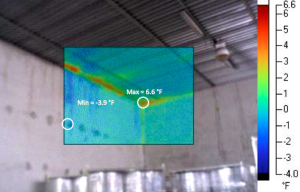
When non-engineers hear the term “building envelope” they typically think of drafty old homes with leaky windows and steam radiators overheating a bedroom while uninsulated parts of the house remain frigid. Cash for Caulkers (the currently proposed and stalled Federal legislation) epitomized the fix for this problem – create new green jobs by arming construction teams with caulk guns for sealing old windows and doors and insulation to stuff into hollow walls, saving taxpayers money and helping our economy.
When energy engineers hear the term building envelope they have a more measured reaction.
These engineers know that low-cost air sealing around windows and doors (ie. applying caulk) can often produce immediate financial payback. They also hear their customer’s misconception that installing new windows, doors or another layer of insulation must also have an immediate financial return. Thermal images of almost any facility visually display wasted energy leaving a building – and since energy is money, the presumption is it must be a great investment, right?
The reality is that the energy math, not the image, drives the investment calculation.
Long run-hour commercial buildings with relatively high cost of energy and good utility incentives can indeed see 5-10 year paybacks on building envelope retrofits. However, energy engineers know that these upgrades more typically have 10-30 year returns on investment, a long time compared to most other energy efficiency measures (HVAC controls, lighting or free behavior change savings.) Although new windows in your home make it feel tighter, the incremental energy cost savings can be minimal where you have low-cost natural gas powering your 10 year old 84% efficient boiler and you already turn down the heat when you head to work in the morning.
At our Halloween themed team meeting this past week Rob presented a whole-building assessment we had completed for a Ohio based customer. While his psycho-ward jumpsuit costume distracted us, he got everyone’s attention when we saw the projected energy savings for upgrading the site’s building envelope – a 4-year ROI!
The explanation was simple. This customer’s site is a freezer cold storage distribution facility.
Keeping a building freezing all year round is expensive (typically using between 1 and 3 kWh annually per cubic foot) and these high energy density facilities can see proportionally high returns for building envelope upgrades. While the cost of energy in Ohio is relatively low (in this case $0.07 per kWh) the Ohio state and utility incentives are strong and these particular upgrades are at a relatively low cost.
So even our energy engineers were impressed with this fast payback building envelope investment.

